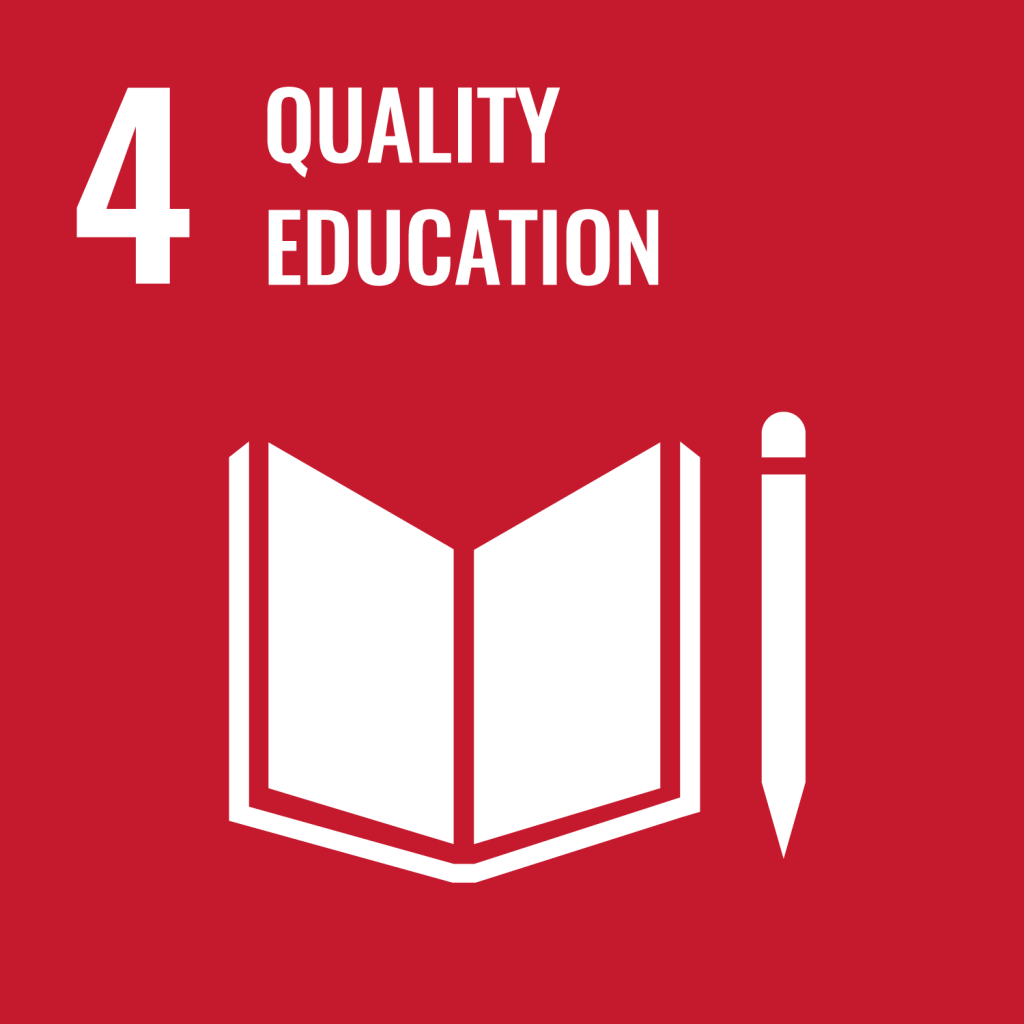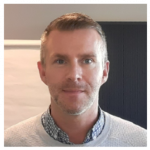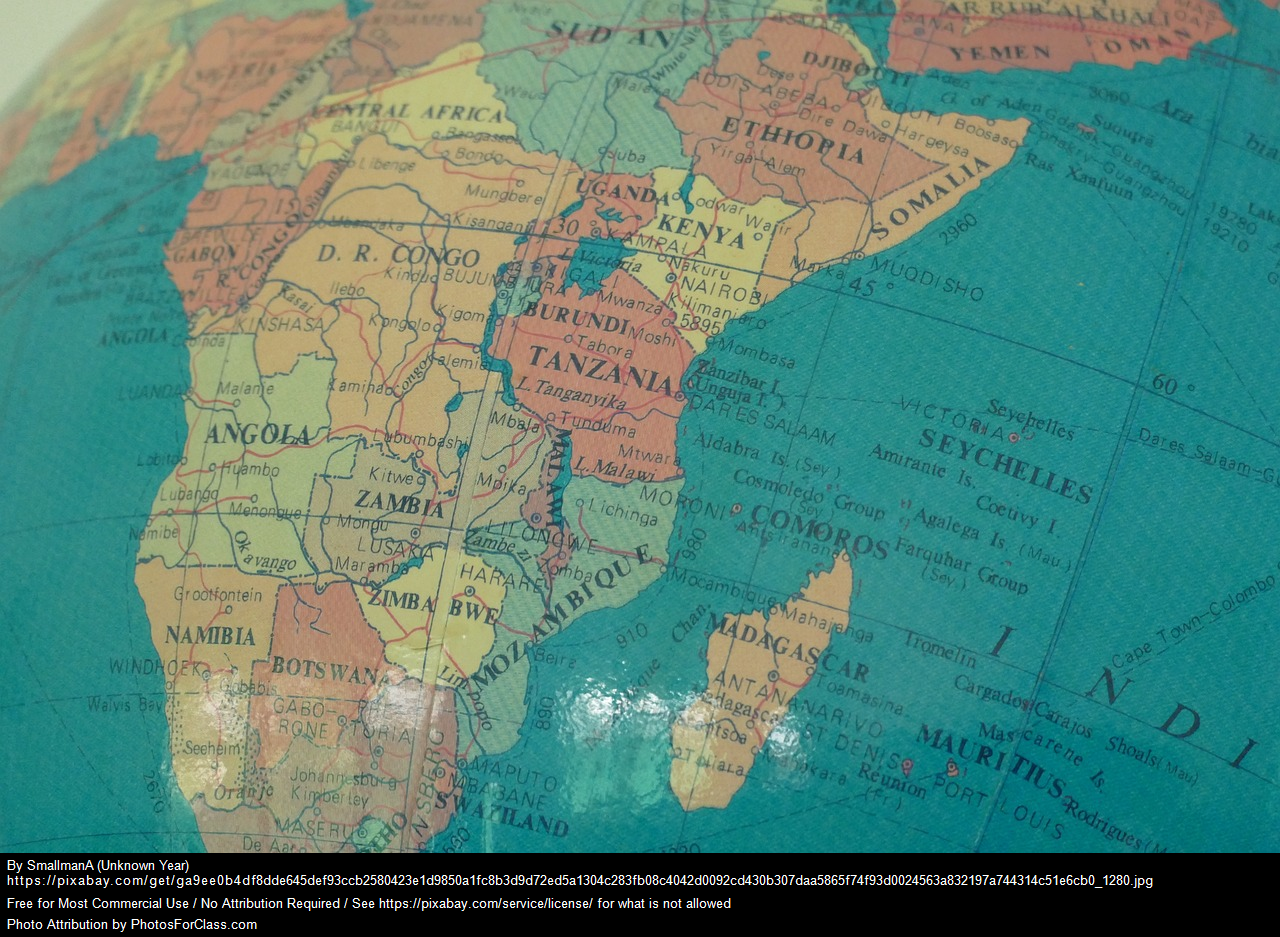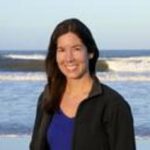Unit 8 Children and Young People: SDG4
Quality Education

Goal no. 4 of the 2030 Agenda for Sustainable Development aims to ensure inclusive and equitable quality education and promote lifelong learning opportunities for all.
Click on the arrows to reveal more information about SDG4. You don’t need to remember everything you read – the main thing is to get an overview of this Goal.
Information and targets reproduced under the terms and conditions of United Nations websites. Copyright (2023). All rights reserved.
A reminder that links in this e-book do not open in a new tab. If you click on any of the links to a webpage, click the back button in your browser to return here.
Key vocabulary
Check that you know the meaning and the whole word family of these key words before you begin the Unit. (NOTE: there may be other versions of the word forms – these are the common forms in the context of SDG4). Also notice some common collocations in bold in the ‘Why this goal? and ‘Targets’ sections above. Add any new words, word families or collocations that you would like to remember to your vocabulary book.
Verb Noun Adjective
To educate educator educational
To be literate literacy literate
To enrol/to be enrolled in enrolment
Introduction – The global education crisis
In Unit 7 you learned about the way that growing up in poverty affects the life chances of children across the whole of their life. Education is a basic human right yet people living in poverty, who need education the most, are the least likely to attend school.
Before you read
- The infographic tells us that rates of illiteracy (the inability to read and write) are much higher for women than for men. Can you think of any reasons why?
- In Unit 6 you learned the word ‘caste’. Can you think of any ways that caste might impact on a person’s education?
- As well as gender and social status, can you think of any other factors that might prevent children and young people from receiving a quality education?
Read
Read the infographic and complete the 3 tasks below. Use the arrows underneath the slides to move between them, scroll down if necessary to see the whole task, and click the check button when you have finished to see the answers.

Download the transcript here Unit 8 infographic – transcript
In your local context…
- The goal to achieve quality education for all is significantly off-track and unlikely to be achieved by 2030. According to a report by UNESCO ‘One in six of all 6 to 17-year-olds will still be excluded [from school] in 2030, and 40% of children worldwide will fail to complete secondary education’ (UNESCO, 2019). How evident is this in your context?
- Can you think of ways that lack of progress on SDG4 (the focus of this unit) is likely to impact progress towards the other SDGs? (See all of the goals on the Welcome page).
Grammar – Second conditional
The summary of the infographic includes a series of ‘if’ sentences:
If all children acquired basic reading skills, 171 million fewer people would live in poverty (a 12% reduction in global poverty).
The grammatical structure tells you that the speaker is not confident that all children will learn to read any time in the near future.
Focus on the second conditional
The second conditional is used to imagine present or future situations that are probably not going to happen or come true.
The structure is usually if + past simple, plus would or could + infinitive (either clause can come first).
If all children acquired basic reading skills, 171 million fewer people would live in poverty.
Practice
Speaking – The Global Education Crisis
Think about your personal response to the information contained in the infographic and then share your views with your partner. You can use these prompts to help organise your thoughts, or you can discuss anything else that comes to mind.
- Did you feel strongly about any of the information?
- Did you find any of the 5 reasons why fighting illiteracy matters particularly compelling?
- Is any progress being made in your local context to address the education crisis?
- How confident are you in our ability to achieve the goals of SDG4 Quality Education?
Listening – Higher education in refugee camps (5 mins)
![]()
Credit: The Conversation, Pasha 68. Digital editor: Ozayr Patel. Licence: CC BY NC ND

Before you listen – Prediction
- You’ll hear about the lives of young adult refugees in refugee camps. Education is crucial for many refugees, offering future possibilities and a way to get a job. But how can people get a higher education in a refugee camp where challenges – such as a lack of infrastructure – are everywhere? It is possible, as long as the education programmes are tailored to the needs of the refugee students. In this listening you’ll hear from Paul O’Keeffe, and three refugees at Kakuma, Kenya talking about their higher education. Can you predict:
- some of the challenges refugees face while in refugee camps.
- how long young people spend in camps before being settled.
- what some of their main educational needs might be.
- Look at the word cloud created from the transcript. The most frequently used words (the biggest ones in the cloud) are: education (14), camps (11), higher (7), course (7), refugee (6). With the title in mind (‘Higher education in refugee camps’) create a sentence that uses as many of these words as possible and predicts the main point of the listening.

Listen
Play the audio here.
(Or access The Conversation podcast and listen from the start to 5.31mins).
In the introduction (0 minutes – 2.30 minutes) Paul O’Keeffe talks about why there is an increase in demand for higher education in refugee camps. Before you listen read the list of factors that can explain this increase. Listen to the introduction and do the two tasks. Stop and start the audio if you need time to do the task.
- What is the average length of time people remain in refugee camps?
-
Listen to the rest of the audio (2.30 minutes to the end). As you listen make notes in the text box for each of the 3 young people (click the ? for helpful information). When you have finished click the ‘copy’ button if you’d like to save your notes to your own device.
NOTE: The ‘check’ button does not supply any useful feedback on your writing. Instead, see the suggested answers below.
Download the transcript here: Unit 8 transcript
Read – Young refugees share what it’s like trying to finish school, find work and get married
Before you read
- You’ll read about Daahir, who at the age of 10 left his home country of Somalia with his family and travelled 1,800 km through Kenya to Kampala in Uganda, where they became refugees. Can you locate Somalia and Uganda on the map?
- Can you predict what caused Daahir’s family to leave their home country and make the arduous journey to Uganda? What do you imagine the journey was like?
- The life chances of refugees are often negatively impacted. In countries where they settle young refugees are often denied the economic, educational or social opportunities which would enable them to thrive. In the vocabulary about adversity in Unit 7 you learned the term ‘thrive’. Can you give a definition?

Vocabulary – Being a refugee
The text is full of vocabulary associated with being a refugee. Complete the definitions, and then select the appropriate word to complete the sentences below.
Skim read for main idea
In the listening in Unit 7 you heard about research from the University of Dundee, UK and the ‘story maps’ made by young homeless people. The researchers also conducted a project on how being a refugee affects young people’s transitions to adulthood. Read the first sentence of paragraphs 2 – 9 (max 2 mins) to find out about the project. When you have finished, summarise what you can remember.
Read for detail
Click the ‘copy’ button to save your notes to your own device. NOTE: The ‘check’ button does not supply any useful feedback on your writing. Instead, see some suggestions below the text.

Dr. Laura Prazeres , Post-Doctoral Researcher, University of Dundee, UK.
In 2012, at 10 years of age, Daahir sat in his school classroom in Mogadishu, Somalia. The sounds of gun shots piercing the air interrupted the lesson. As Daahir ran back home, he overheard that fighting had erupted between government forces and the militant group Al-Shabab. Daahir arrived home to find his father dead from gunshot wounds. Faced with further threats and imminent violence, Daahir and his family, along with many others, fled their home country in search of safety and stability abroad.
According to the UN refugee agency (UNHCR), 51% of the world’s refugee population is under the age of 18. That means some 600m young people are living in unstable or conflict affected areas across the globe. There is an urgent need to understand how young people are affected by forced migration over the course of their lives. That’s why, in 2017, the Department for International Development commissioned Professor Lorraine van Blerk, Dr Wayne Shand and myself at the University of Dundee, to conduct a research project on how being a refugee affects young people’s transitions to adulthood.
Adulthood is not a fixed stage which is attained at a specific age. Rather, it’s achieved by crossing boundaries such as leaving your parents’ home, completing education, getting a job and, in many cultures, entering into marriage. These transitions are complex processes, which typically involve close relationships with family or caregivers.
But young people who have been displaced from their homes or live in poverty are often denied the economic, educational or social opportunities which would enable them to pass these milestones. Often, their environment forces them to be dependent on their family, or other forms of support, for longer. The processes which young people go through on their way to adulthood can be accelerated, delayed or reversed, as they try to reconcile their personal plans for the future, with hardships they are encountering every day as refugees.
As part of our research, we trained and supported refugees between the ages of 15 and 24 as youth researchers to conduct interviews and surveys among their peers in Uganda and Jordan. The youth researchers and their participants in Uganda came from Somalia and the Democratic Republic of Congo, while those in Jordan were Syrians, Iraqis and Palestinians from Gaza. Daahir – the young Somali participant – was based in Kampala, Uganda. We took this approach on the basis that all young people are experts on their own lives, and capable of expressing their needs when they are given the opportunity to do so.
We encouraged our youth researchers to take photographs and make drawings and videos with other young refugees to depict what it’s like growing up as a displaced person. We put together the material they produced to create an online story map – a multimedia platform which illustrates the project’s findings and tells the personal stories of young refugees.
For the young refugees who took part in our project, education, work and family life were the main sources of disruption during their transition to adulthood. Education is often a requirement for getting a decent job, and the loss of education certificates through conflict and displacement has made it difficult for young refugees to continue their studies. Many feel like “failures” for not completing their schooling and being unable to find decent work.
The young refugees’ lack of qualifications and social connections in both Uganda and Jordan have made it difficult to find work and sustain a livelihood. Getting married and starting a family is viewed as another means to establish social and adult status, but the cost of a dowry and wedding expenses prevent young refugees from completing this rite of passage.
Financial issues are not the only hindrance: the instability of their circumstances discourages young people from entering into marriage, as it can complicate and worsen conditions for both parties involved. It might also conflict with aspirations for the future, such as relocating and settling down elsewhere.
Finding a path
Daahir didn’t just lose his father to the war in Somalia – he also lost years of education, as he migrated through different countries. Daahir is still completing primary school in Uganda at 15 years of age. In Somali culture, 15 is the age when a young person is considered an adult. But the interruption and delay of Daahir’s education, due to displacement and lack of money, has had a ripple effect on his transition into adulthood, both personally and within the Somali refugee community.
The delay and rupture Daahir has experienced as he is growing up will have a significant impact on his future. Daahir’s diminishing interest and motivation in school may affect his ability to lead a successful adult life. With many years of school left ahead of him – and his family living in a precarious financial situation – Daahir will need to grapple with difficult decisions such as whether to continue his education, look for work and/or start a family, as he transitions from childhood to adulthood and develops different needs and aspirations.
Displacement and forced migration rupture young people’s plans for their adult lives. So specific support is needed to ensure that the changes to their pathways into adulthood are addressed in a positive way. The nature of conflicts and crises make it difficult to prevent these ruptures, but agencies and governments can tailor support to be more responsive to the realities of being a young refugee.
NB This version of the article, with permission from the author, does not include the hyperlinks to supporting articles found in the original. Click the title for the full version of the text, published under a CC BY ND licence in The Conversation, which should be used for reference and sharing.
Vocabulary – Suffixes
Daahir is a refugee. The suffix -ee can be added to transitive verbs to form words meaning a person or thing that is the object of that verb. In this example the verb is to take refuge, and the person that is the object of the verb is a refugee.
Practice
Pronunciation: Suffix -ee
1. In Unit 5 you learned some word families. Here are four more word families (from the sentences above). What are the missing forms from the table? Add the four completed families to your vocabulary book, and check any forms you are unsure of in the online dictionary (see answers below).
2. Play the audio here:
Play the audio and as you listen mark in the main stress for each member of the word family. What do you notice about the suffix -ee?
|
Verb |
Noun |
Noun person |
Noun person who is the object of the verb |
|
To take refuge |
a refuge |
|
a refugee |
|
To interview |
|
|
|
|
To train |
|
|
|
|
To employ |
|
|
|
Grammar – Present perfect (present result of past actions)
Most of the reading (‘Young refugees share what it’s like trying to finish school, find work and get married’) is written in the present tense or the present continuous to describe the refugees and their current experiences. The two sentences below use the present perfect (active and passive), however.
The delay and rupture Daahir has experienced as he is growing up will have a significant impact on his future.
Young people who have been displaced from their homes or live in poverty are often denied the economic, educational or social opportunities which would enable them to pass these milestones
Present perfect to show the current impact of past actions
-
He has lived in Uganda since he was 10.
And it can be used when we are talking about our experience up to the present, as in these 2 sentences (active and passive) from the text:
-
The delay and rupture Daahir has experienced as he is growing up will have a significant impact on his future.
-
Young people who have been displaced from their homes or live in poverty are often denied the economic, educational or social opportunities which would enable them to pass these milestones.
The focus in these 2 sentences is on the impact that the past experience continues to have in the present.
Practice
2. The writer made a choice to use the present perfect. In each sentence, decide what the use of the present perfect allows her to say about the current impact of past actions. For example, in the first one using the present perfect allows the writer to not only say what happened (Daahir and his family were displaced) but also to show that they are still living in a foreign country, and that they are not in their homeland.
Vocabulary – Adjectives of nationality
Daahir comes from Somalia. He is Somali. Look at the illustration and notice the 5 different types of endings for adjectives of nationality (-ese, -an, -ian, -i, -ish).

Download the transcript here: Adjectives of nationality transcript
Practice
1. What is the adjective of nationality for your country? Do speakers of other languages usually get it right?
2. Do you know the adjective of nationality for each of these countries? They all have one of the 5 endings.
Bahrain Brazil Britain Cameroon Canada Denmark
Finland Hungary Ireland Italy Kenya Korea
Mexico Oman Poland Senegal Singapore Vietnam
Writing
In this Unit you’ve learned about the global education crisis, and the difficulties children and young people have gaining an education. This story of efforts to keep girls in school in Iraq continues the theme.
Read the story and write a response to it that incorporates what you know about opportunities and life chances for children and young people, especially girls, and their access to education. Write about:
- How the UN supported schools in Iraq during the Covid-19 pandemic.
- What often happens to girls if they are not in school.
- The role of mobile phones in education in this context.
- Any other topic relevant to the life chances of children and young people and SDG4.
‘It will Help Me to Achieve My Dream’: Helping Iraqi Girls Stay in School
When COVID-19 hit Basra in southern Iraq, the academic prospects for many schoolgirls were put at risk as institutions closed to slow down the spread of the virus. In response, the UN Children’s Fund (UNICEF) and the World Food Programme (WFP) conducted a trial cash stipend programme to support 2,570 primary school children for their continued education.
“This will help me achieve my dream of becoming a dentist,” says 12-year-old Baneen. Many families receiving the stipend use the money to buy their children a mobile phone for the sole purpose of online and e-learning activities. Girls in the project also joined a newly created coding club, for studying in a safe environment, learning new tech skills and innovating to create digital solutions. By keeping girls in school and completing their education, their expanded opportunities help prevent girls from marrying or working too early.
“The mobile phones have been helping with online study”, explains Principal Zainab Karim, a headteacher in Basra. “Many schoolchildren live in the same home as several other children, and share the same phone as their moms and dads. The students benefit from having their own phones.”
Department of Economic & Social Affairs Statistics Division (2022) ‘Bringing Data to Life: SDG impact stories from across the globe.’ Available at: https://unstats.un.org/sdgs/report/2022/SDG2022_Flipbook_final.pdf
Speaking
Read the summary and discuss the questions that follow:
SDG4 Summary
Ensure inclusive and equitable quality education and promote lifelong learning opportunities for all.
Natural disasters greatly affect the education sector by destroying key infrastructures, disrupting the education cycles and forcing children to drop out of school for extended period of time. At the same time education is a powerful tool to build societies’ resilience. Formal and informal education, including, public awareness and training are critical for promoting sustainable development and improving the capacity of the people and countries to address environmental and development issues and to create green and decent jobs and industries.
Reproduced with kind permission of the UN Environment Programme. Copyright (2023). All rights reserved.
- The life chances of many children and young people around the world are limited. They miss out on education because of their gender, or the need to work, or because they are fleeing danger, and they may be separated from their families in conflict zones. Why do the goals of SDG4 Quality Education ‘to ensure inclusive and equitable quality education and promote lifelong learning opportunities for all’ matter?
- Can you give a definition for the words in bold above?
A reminder that if you have access to the internet and are studying by yourself without other people to practice your spoken English with, you can use artificial intelligence (AI) to gain fluency practice. See here for instructions and prompts.
Here are some prompts related to this Unit:
- ‘Tell me about the rates of illiteracy for women compared to men in [insert name of country]. Let’s have a dialogue about the reasons for the difference. You begin and then ask me what I think.’
- ‘Tell me about the lives of children who live in refugee camps. Create 5 questions for me to answer based on the information you have given me, and then tell me if I have got the answers right.’
- ‘Tell me some of the reasons that children miss out on education. Let’s have a dialogue about how we can ensure that all children receive a quality education.’
Extension activities
After every two Units you are offered a choice of extension tasks. Use the menu bar on the left-hand side of the screen to access Extension Activities Units 7 and 8.
End of Section 2 – Life Chances
This is the end of Section 2. Think about:
- Four key things that you found out by working through the topics (SDG5 Gender Equality, SDG10 Reduced Inequality, SDG1 No Poverty, and SDG4 Quality Education).
- One language skill that you think you have developed a bit further.
- Some new vocabulary items that you have mastered (i.e. you can remember them and use them appropriately).
- An area of language that you would like to develop further.
- Any lifestyle change that is possible in your context to help achieve the aims of one or more of these SDGs.

